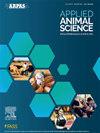Effects of reducing dietary nutrient density after the second dose of a gonadotropin-releasing-factor immunization on growth performance and carcass characteristics of intact male pigs and market gilts
IF 1.5
Q3 AGRICULTURE, DAIRY & ANIMAL SCIENCE
引用次数: 0
Abstract
Objective
The effects of reducing dietary nutrient density after the second dose of gonadotropin-releasing- factor (GnRF) immunization on growth performance and carcass characteristics of intact male pigs and market gilts were investigated.
Materials and Methods
During this 102-d grow- finish study, one dietary program was formulated to meet the recommended ratio of standardized ileal digestible (SID) lysine to NE for nonimmunized physically castrated males and nonimmunized market gilts, and another dietary program was formulated with greater SID lysine for GnRF-immunized pigs than for physically castrated males (15.0% to 20.0% greater SID lysine). During the final 2 dietary phases (final 46 d), additional treatment diets were formulated for diets fed to GnRF-immunized pigs to evaluate nutrient dilution programs (consisting of diluted AA, vitamins, and trace minerals).
Results and Discussion
There were no significant linear effects of diet dilution for G:F or hot carcass weight (HCW) for either male or female GnRF-immunized pigs. For the overall period, G:F was improved and HCW was greater for male GnRF-immunized pigs when compared with nonimmunized pigs. Additionally, G:F tended to be improved, whereas HCW was not different, for female Gn- RF-immunized pigs when compared with nonimmunized pigs.
Implications and Applications
Diluting nutrient density during the post-second-dose period of GnRF im- munization did not affect growth or carcass attributes, and both male and female GnRF-immunized pigs grew faster and were more feed efficient compared with nonim- munized pigs.
第二次免疫促性腺激素释放因子后降低饲粮营养密度对完整公猪和市售后备母猪生长性能和胴体特性的影响
目的研究第二次免疫促性腺激素释放因子(GnRF)后降低饲粮营养密度对完整公猪和市售后备猪生长性能和胴体特性的影响。材料和方法在102 d的生长肥育期试验中,设计了一种符合未免疫物理阉割公猪和未免疫市场后备母猪推荐的标准回肠可消化赖氨酸(SID)与NE比值的饲粮方案,并设计了另一种比物理阉割公猪更高SID赖氨酸的饲粮方案(SID赖氨酸高出15.0% ~ 20.0%)。在最后2个饲粮阶段(最后46 d),为gnrf免疫猪的饲粮配制额外的处理饲粮,以评估营养稀释方案(包括稀释的AA、维生素和微量矿物质)。结果与讨论饲粮稀释对gnrf免疫公、母猪G:F和热胴体重(HCW)均无显著的线性影响。在整个周期内,与未免疫猪相比,雄性gnrf免疫猪的G:F得到改善,HCW更高。此外,与未免疫猪相比,免疫母猪的G:F有提高的趋势,而HCW没有变化。研究意义和应用在GnRF二次免疫后稀释营养物质密度对猪的生长和胴体特性没有影响,与未接种GnRF的猪相比,雄性和雌性GnRF免疫猪生长更快,饲料效率更高。
本文章由计算机程序翻译,如有差异,请以英文原文为准。
求助全文
约1分钟内获得全文
求助全文

 求助内容:
求助内容: 应助结果提醒方式:
应助结果提醒方式:


